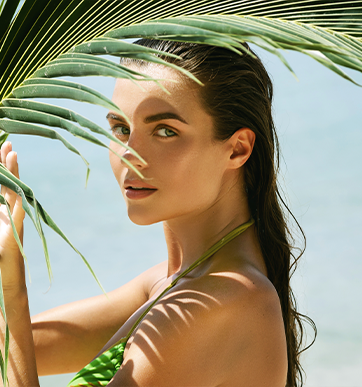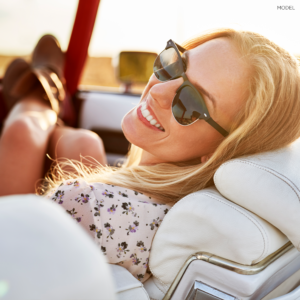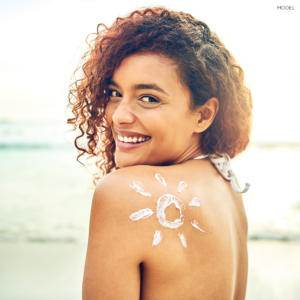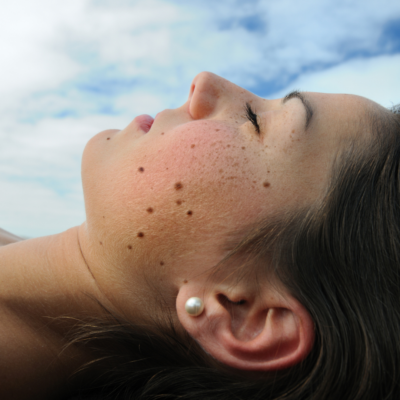
How to Keep Your Skin Safe While Enjoying the Sun
Here comes the sun!
When the sun is shining on a hot summer day, we all want to hit the beach or lounge poolside. However, July is Ultraviolet Safety Month for good reason. While you may not be able to avoid sun exposure during peak UV radiation time between 10 am and 4 pm, we would like to provide with you other real life tips on how to enjoy the sun while keeping your skin healthy and damage-free.
Protect Your Eyes While Sunning
 Even meticulous sunscreen users miss around 10% of their facial skin – mostly the corners of the eyes, the bridge of the nose and the eyelids. Eyelid skin happens to be the thinnest skin on the body and thus more prone to the harmful effects of UV light, including skin cancer.
Even meticulous sunscreen users miss around 10% of their facial skin – mostly the corners of the eyes, the bridge of the nose and the eyelids. Eyelid skin happens to be the thinnest skin on the body and thus more prone to the harmful effects of UV light, including skin cancer.
What to do
Be sure to apply sunscreen to those areas. If sunscreen stings your eyes, ask your California Skin Institute board-certified dermatologist to help you find a sunscreen formulated for sensitive skin. Also, choose quality UV filter sunglasses. The bigger, the better. Dark lenses with wide earpieces can also help to stave off crow’s feet and wrinkles.
UPF Clothing – Help or Hype?
If you apply sunscreen before heading out for a day in the sun and tend to forget to reapply, UPF clothing may be for you. You may be thinking, don’t all clothes provide a barrier to the sun? Well, yes, but that’s like saying if a ceiling fan cools a room, why have air conditioning? It’s a matter of better technology providing better outcomes.
Most clothes we wear are made from fabric that light can penetrate. With sun protective clothes, not only is the fabric’s weave tighter, it’s made from special synthetic fabric developed to form a barrier against the sun’s rays. Created and tested by textile chemists in the 1990s, sun protective clothing’s performance seems to be consistent with claims about their effectiveness.
What to do
Most sun protective clothing could pass for ordinary active wear or athleisure. The pieces come in a range of colors and styles of shirts, slacks, leggings and hats. Some pullover shirts are made out of swimsuit-type fabric to wear in the water. Other long-sleeved shirts are lightweight button-downs suitable for hiking and fishing. Sporting goods stores like REI and Big 5 usually offer an assortment of choices, but there are also online sources.
Keep in mind that while a shirt, pants and hat can give you good sun protection coverage, there are still areas exposed to UV rays, like your hands, neck and face. We recommend using both sunscreen and UPF clothing for optimal protection.
SPF and Other Mysteries of Sunscreen
 That brings us to one of our favorite topics – sunscreen! Sunscreen provides your vital line of defense against skin cancer and premature aging of your skin with wrinkles, creases and brown sun spots. While it’s important to apply sunscreen daily all year round, especially in California, it becomes even more important during summer.
That brings us to one of our favorite topics – sunscreen! Sunscreen provides your vital line of defense against skin cancer and premature aging of your skin with wrinkles, creases and brown sun spots. While it’s important to apply sunscreen daily all year round, especially in California, it becomes even more important during summer.
How much sunscreen is enough?
The American Academy of Dermatology recommends using the equivalent of a full shot glass to cover yourself from head to toe. If you’re only applying sunscreen to your face, use a dessert spoon’s worth to protect yourself from the tops of your ears to the base of your neck.
What do SPF numbers mean?
SPF stands for sun protection factor. Basically, how long the sunscreen can protect you from burning compared to skin without sunscreen. An SPF 50 will allow you to stay in the sun 50 times longer while SPF 30 allows you to stay in the sun 30 times longer. Choose sunscreens with SPF 30 and above.
UVA vs UVB rays
These are essentially two sides of the same coin – UV (ultraviolet radiation). UVA rays have a lower amount of energy and a longer wavelength than UVB rays. They can enter the middle layer of your skin called the dermis. UVB rays have a short wavelength that can only reach the outer layer of skin, the epidermis. Both can cause skin cancer but UVA plays a greater role in aging the skin. Choose broad-spectrum sunscreen that shields you from both wavelengths.
California Skin Institute stays focused on sunscreen research to offer you the most up-to-date formulations. All our sun care products are produced exclusively for us using blends of quality ingredients to both protect and enhance your skin. Contact us for a consultation to find out which of our sunscreens is best for you.
Here’s a handy checklist for UV-safe fun in the sun:
- Hat with a minimum 4-inch brim
- Oversized UV-protective sunglasses
- Long-sleeved sun protective shirt
- SPF 30 or above broad-spectrum sunscreen



 / 291 Reviews
/ 291 Reviews